Government Policy
Research by the Political Psychology Research Group at Stanford University
Introduction Fundamentals Who Should Take Action Government Policy Economic Side Effects Willingness to Pay Priority Consequences of Global Warming Preparing for Possible Consequences Consumer Choices Attitude Strength Voter Behavior Opinions in the States Trust in Scientists Scientists' Beliefs Partisan Views Publications
Given that a large majority of Americans believe that global warming is a problem that should be addressed, it is useful to understand what specific government policies the public supports .
Reduce Emissions
Since 2009, a huge majority of Americans have thought that the United States should limit greenhouse gas emissions generated by businesses (77% in 1997, 78% in 2018), as shown in the figure below.
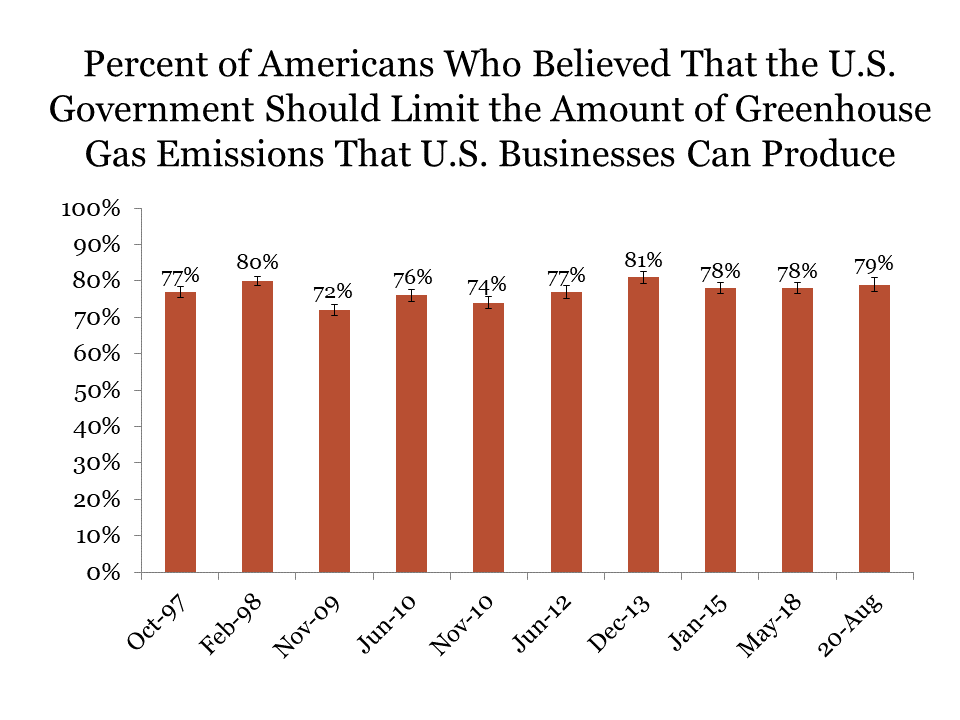
A revenue-neutral carbon tax has been suggested as a policy to reduce greenhouse gas emissions. In 2015, 61% of Americans approved of the idea that companies should be taxed for every ton of greenhouse gases they emit, and public approval increased to 67% in 2018 (see figure below).
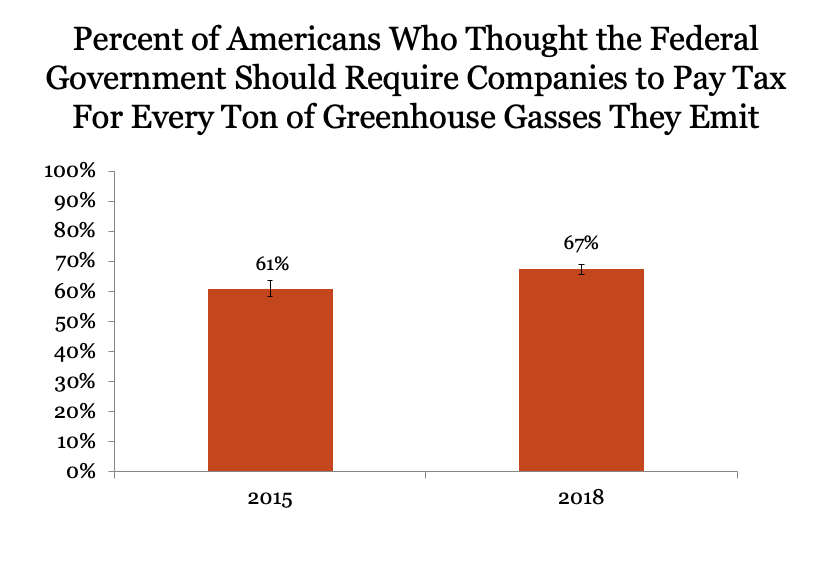
In 2020, respondents were asked different versions of this carbon tax policy in order to explore whether stating that the revenue from the tax would be returned to all Americans in the form of a dividend would change their opinion.
When asked whether companies should be charged a tax for every ton of greenhouse gases they emit without the mention of a dividend, 62% of respondents were in favor. When respondents were told that the tax revenue would be returned to individual Americans as a dividend, responses did not significantly change: 58% of Americans favored a carbon tax with a $200 annual per-person dividend, 63% with a $600 dividend, and 57% with an $800 dividend. None of these were significantly different from the 62% in favor of carbon taxes with no dividend.
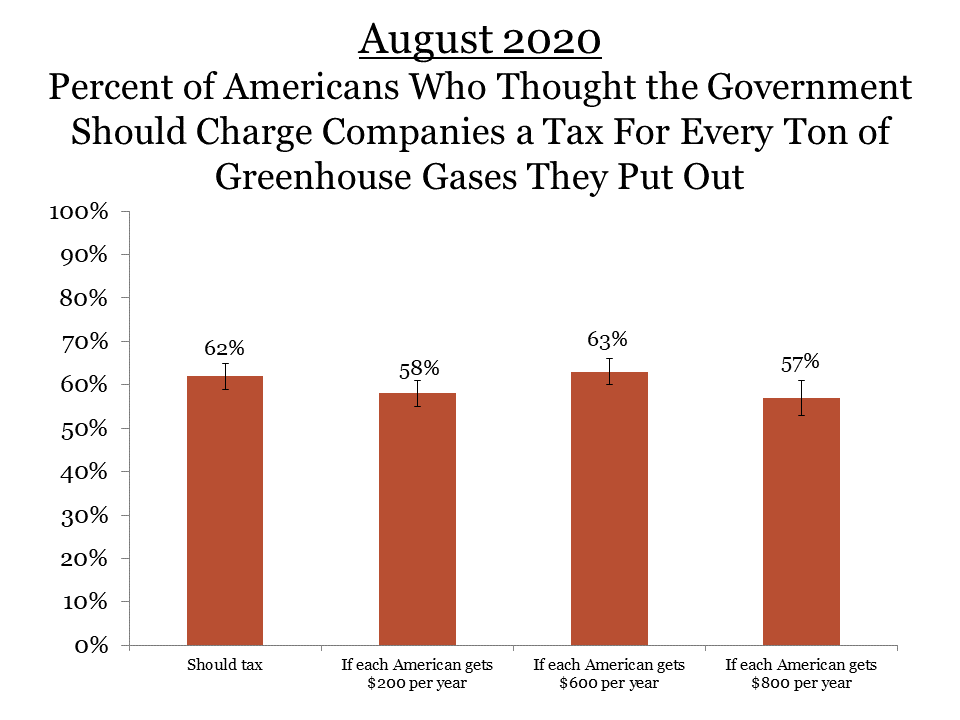
Another strategy would tax emissions from imported fuels. The majority of Americans (67%) in 2015 thought that the federal government should tax companies for every ton of greenhouse gases the companies emit from imported coal, natural gas, and oil. That percentage rose to 78% in 2018 (see figure below).
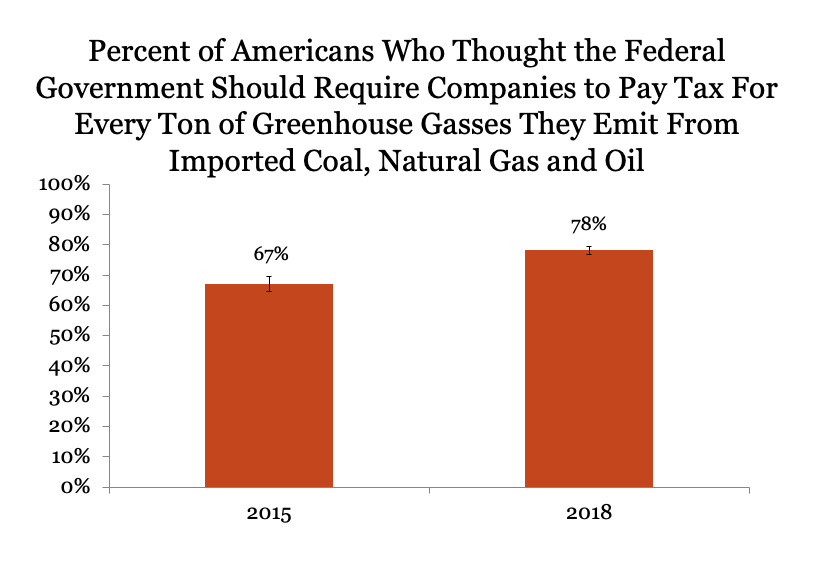
In 2018, the majority of Americans (61%) did not support President Trump’s decision to withdraw from the Paris Accord. Further, 81% said they were in support of the United States maintaining the promise it made before the President’s withdrawal to try to cut the amount of greenhouse gases it produces by about 25 percent from its 2005 levels (see the figure below).
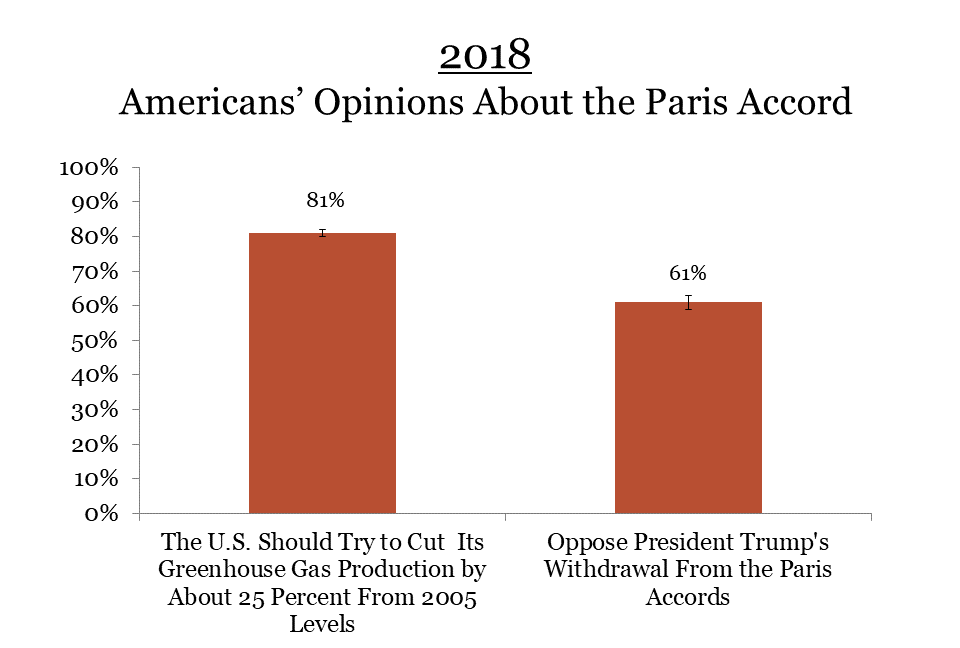
As shown in the figure below, from 2006 to 2018, about 75% of Americans wanted the U.S. government to either require or give tax breaks to lower greenhouse gas emissions from power plants. In 2006 and 2007, more than 85% of people held this belief, and that percentage was 81% in 2020.
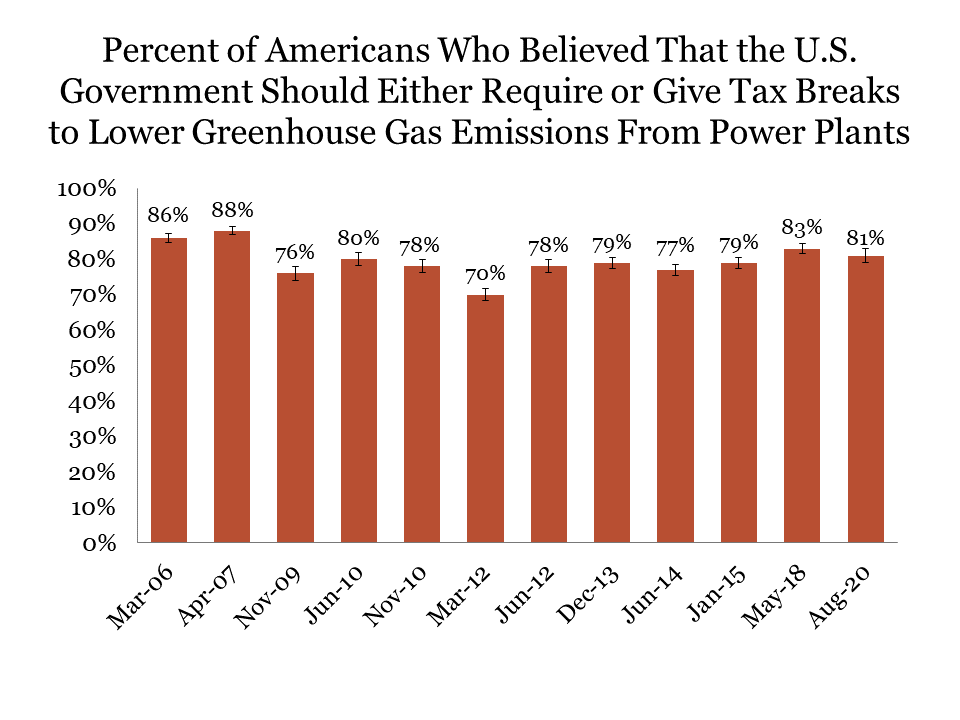
Fewer, but still a majority, said that they believed that the government should give tax breaks to reduce air pollution from burning coal. In 2009, 65% of Americans reported this belief, and 63% of Americans expressed this belief in 2020, as shown in the figure below.
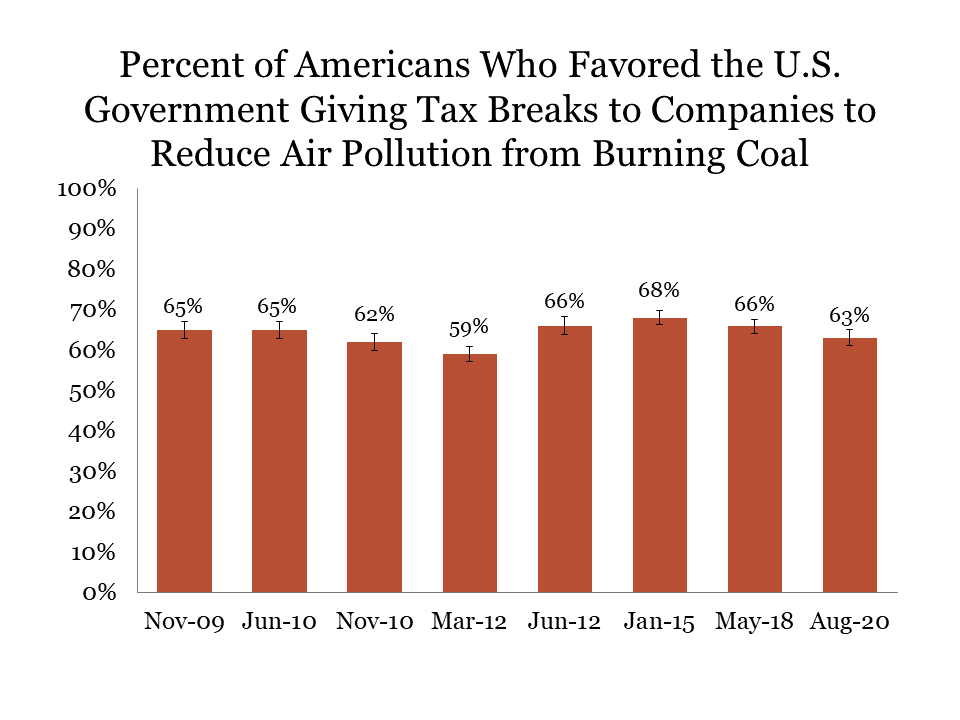
A majority of Americans favored economic penalties for emissions. In 2009, 58% were in favor of the government charging power companies for each ton of emissions they put out. Similarly, 58% of Americans also said they were in favor of the government increasing the cost of items bought from countries that do not control their emissions (see the two figures below).
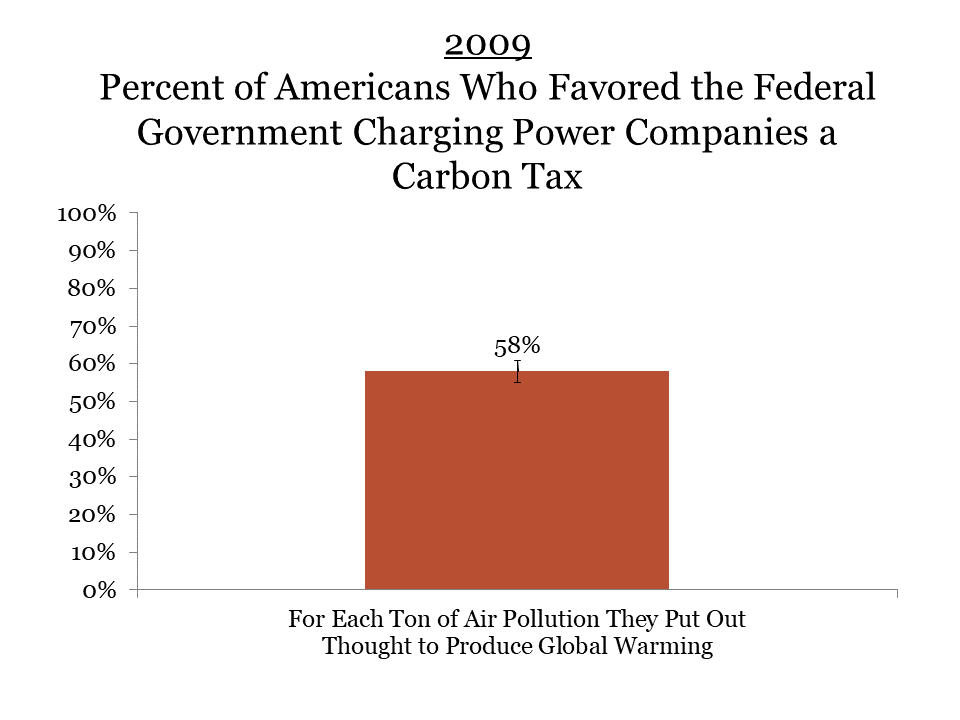
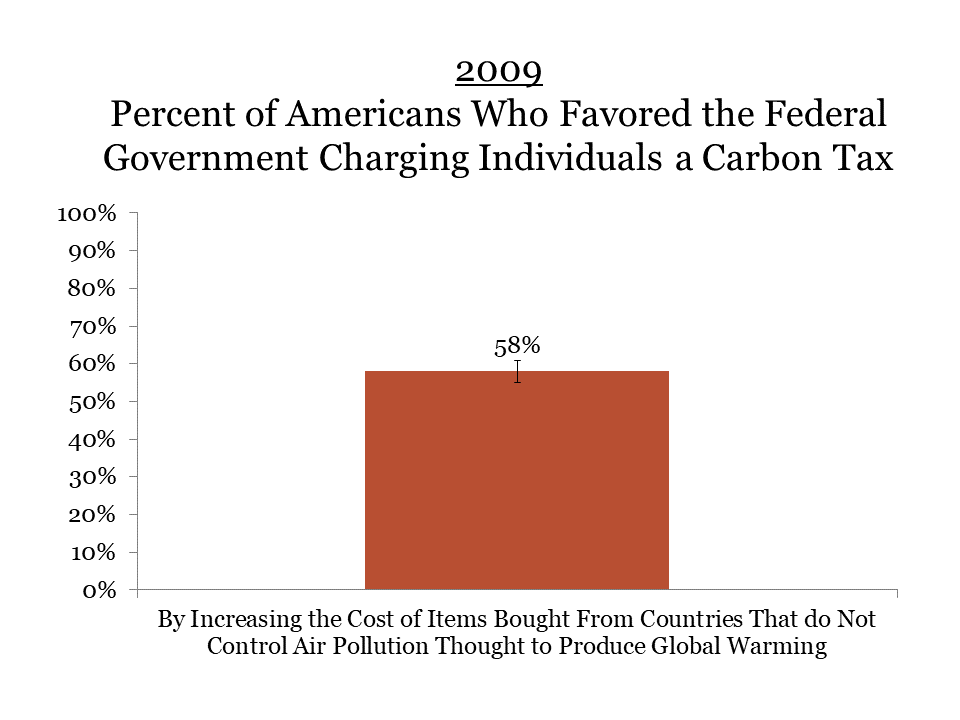
Cap and Trade Policy
“Cap and trade” is a system in which the government would issue permits limiting the amount of greenhouse gases companies can put out. Companies that did not use all their permits could sell them to other companies. Companies that need more permits can buy them, or these companies can pay the money necessary to reduce the amount of greenhouse gases that they put out. This is intended to incentivize companies to reduce their greenhouse gas emissions in the most cost-effective manner possible.
When asked about implementing this type of policy and when told that economists believe that it will lead to cost-efficient greenhouse gas emissions reduction, a majority of Americans said they would favor a cap and trade policy. 59% of Americans favored it in 2013, and 52% saying this in 2015.
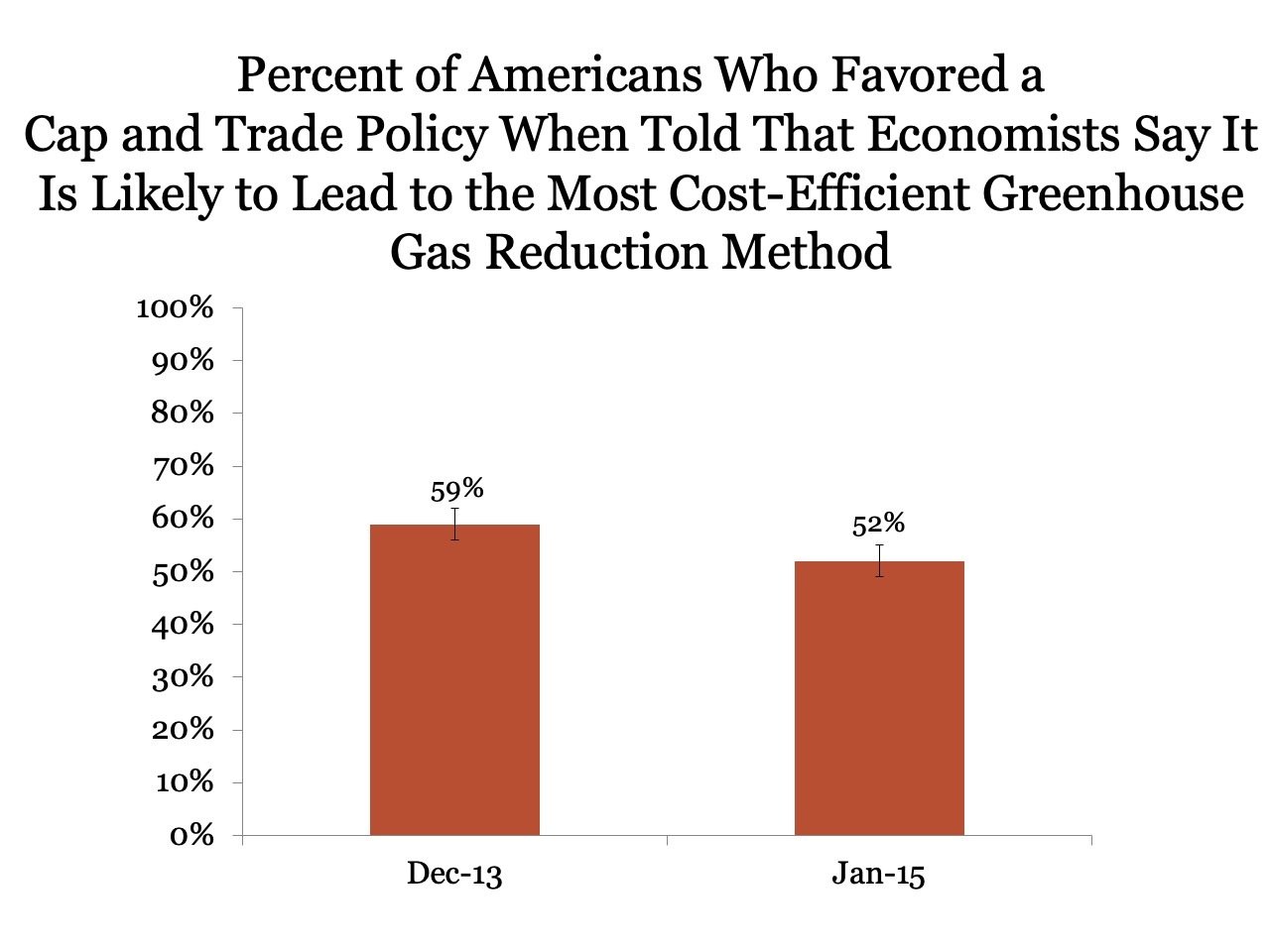
Additionally, when presented to respondents as a “cap and dividend” policy, where the revenue generated by selling the permits to companies is returned to all Americans in the form of a dividend, 65% of respondents favored this policy in 2013, 62% favored it in 2015, and 61% favored it in 2020.
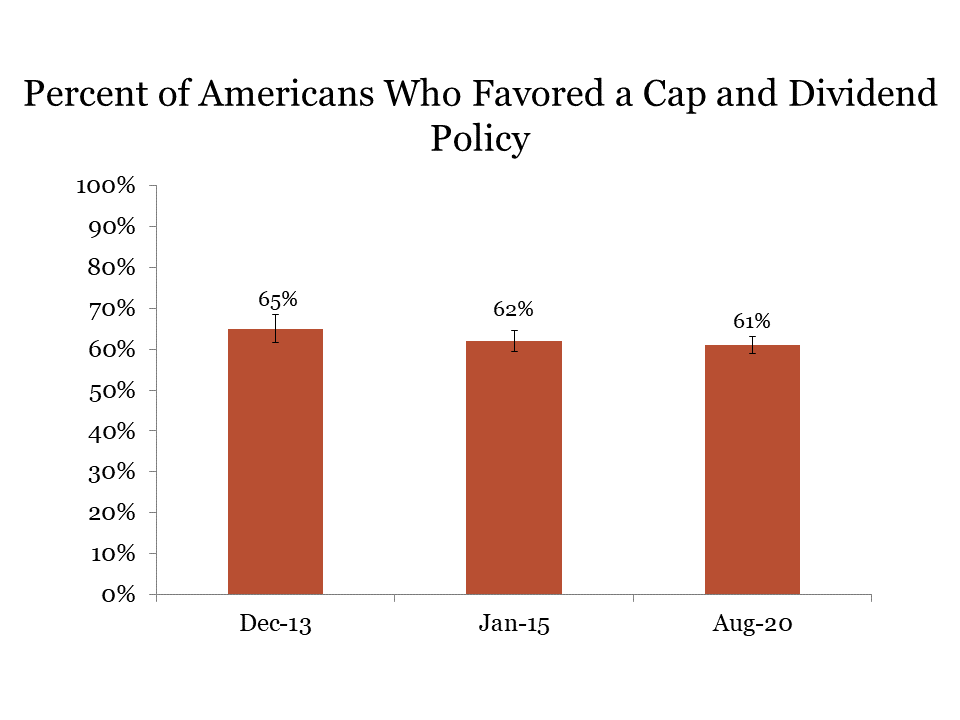
When asked in June 2010 about cap and trade, half of the respondents were provided with a past example of cap and trade policy successfully reducing the amount of air pollution put out by companies, whereas the other half was not. The percent of Americans who favored the policy was 9 percentage points higher when provided with the example than when not provided the example.
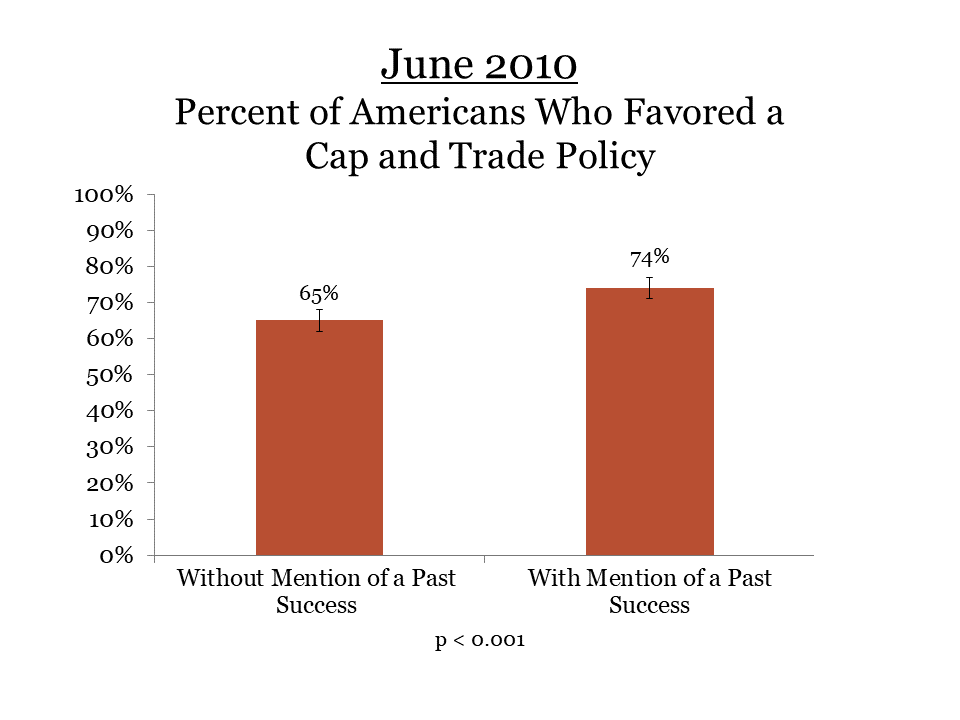
Data collected in June 2010. Read the question wording.
In December, 2013, when one group of respondents was told that “Economists say this system is likely to cause companies to figure out the cheapest way to reduce greenhouse gas emissions” 48% of Americans favored a cap and trade policy. When another group was told that “This will cause companies to figure out the cheapest way to reduce greenhouse gas emissions”, 59% of Americans favored this policy.
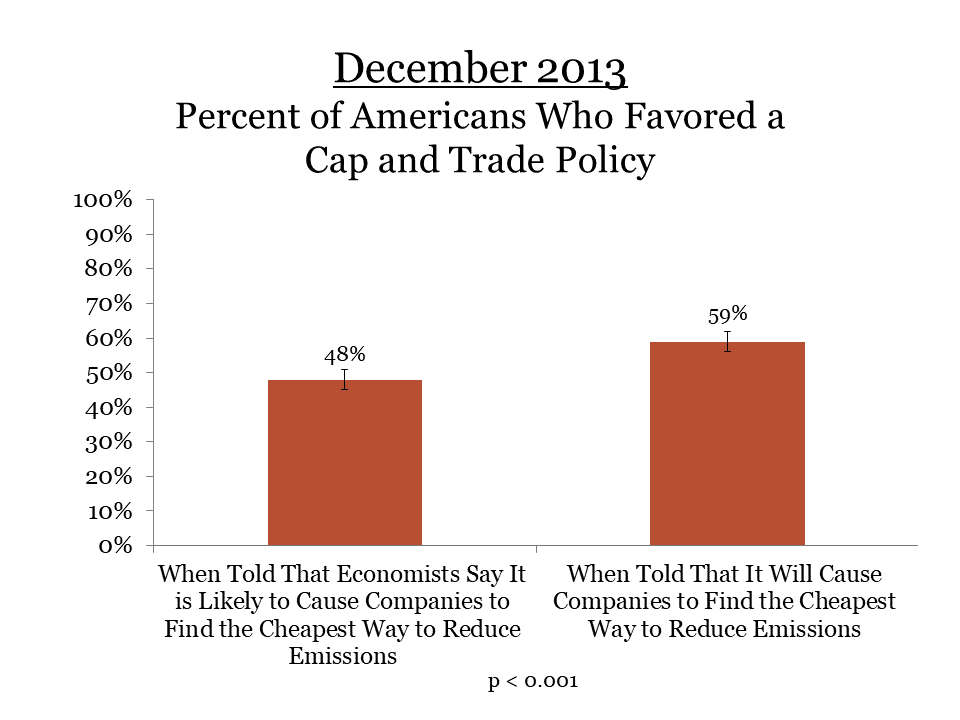
Data collected in December 2013. Read the question wording.
In 2008, 56% of respondents favored cap and trade when told it would add $10 to their monthly electric bill, whereas 47% favored it when told that it would add $25 to their monthly electric bill. Thus, opinions were responsive to economic cost.
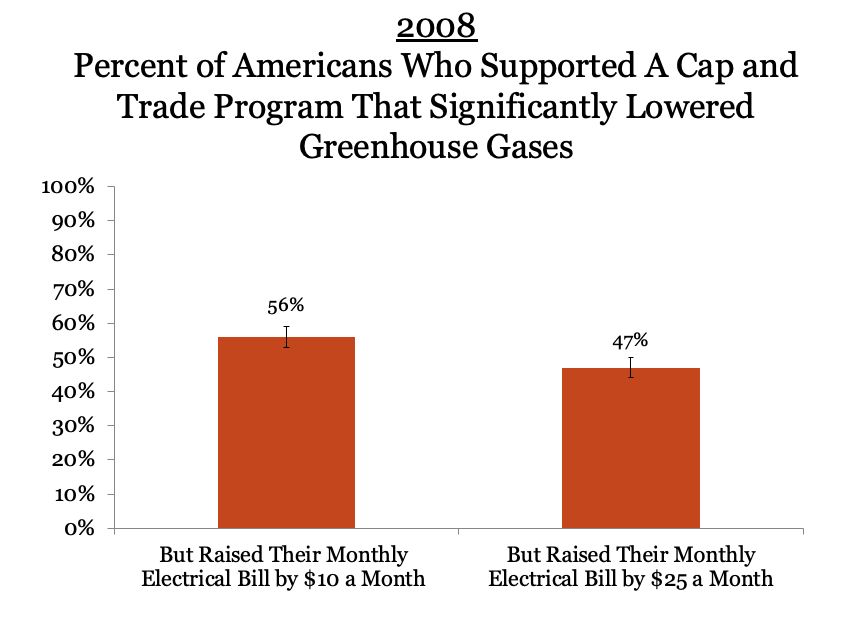
Data collected in July 2008. Read the question wording.
Manufacturing Standards
A majority of Americans believed that manufacturing more fuel-efficient cars should be required by government or should be encouraged with tax breaks. In 2006, 84% held this belief, and that percentage was 71% in 2020 (see the figure below).
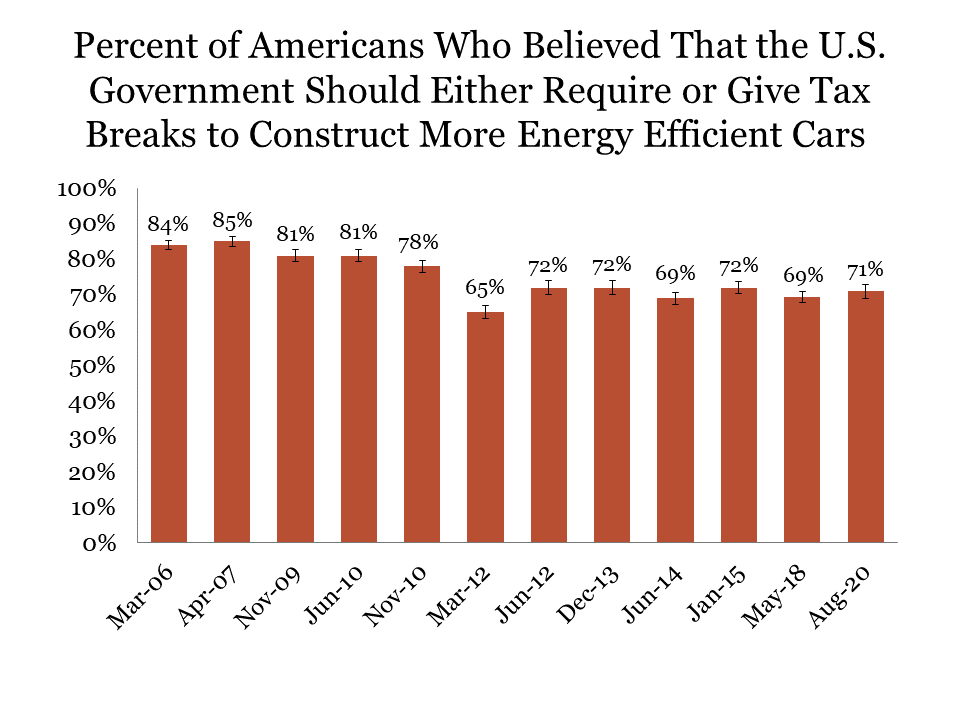
In 2008, more than three quarters of Americans (78%) favored increasing the strictness of government fuel efficiency standards for cars. In 2018, 56% of Americans favored the federal government requiring cars and light trucks manufactured after 2025 to get about 55 miles per gallon (see the figure below).
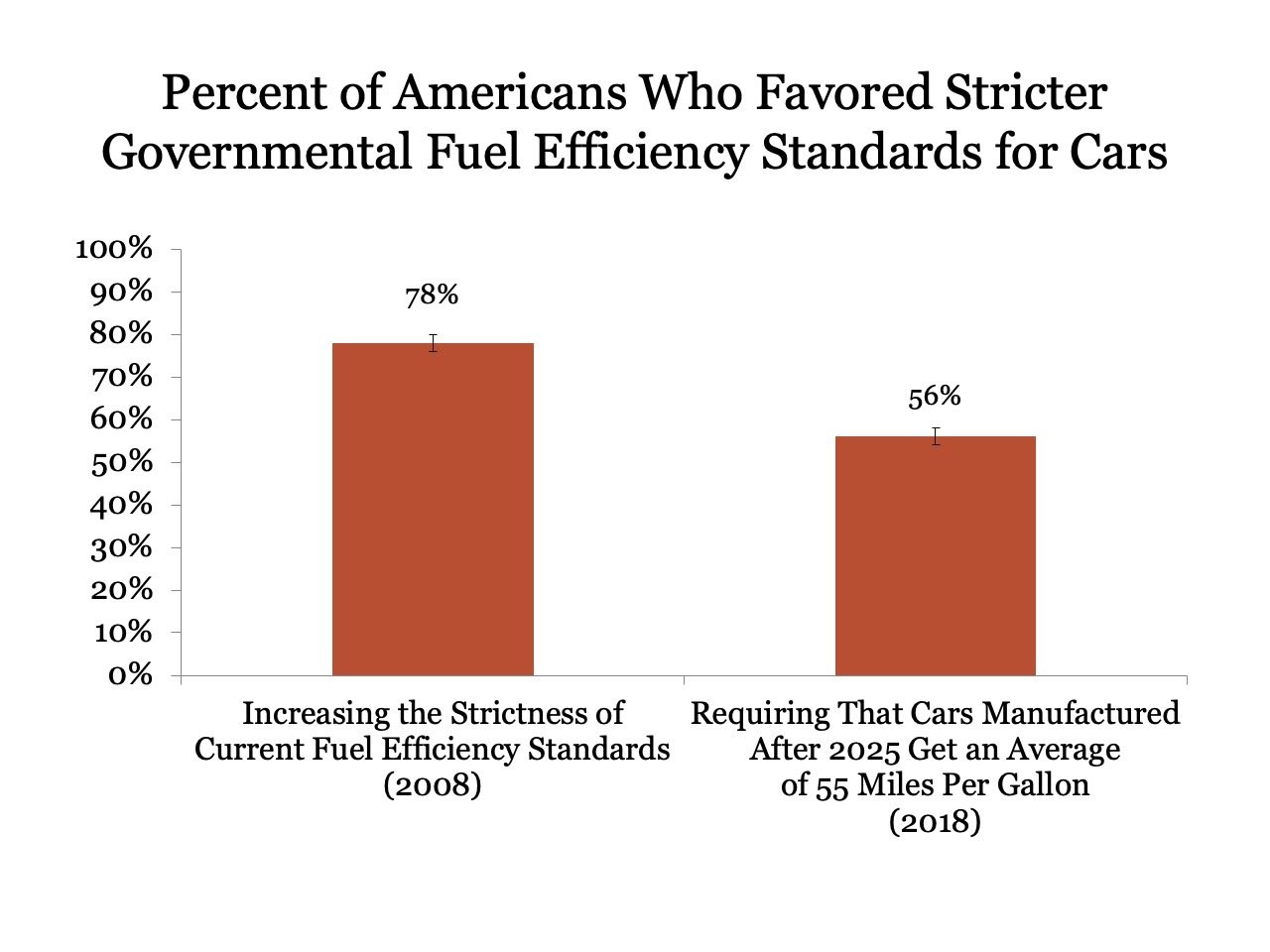
The public also responded positively to increasing energy efficiency in construction, as shown in the figure below. In 2006, 83% of Americans believed that constructing more energy efficient buildings should be required by government or be incentivized through tax breaks. That group was 75% in 2020.
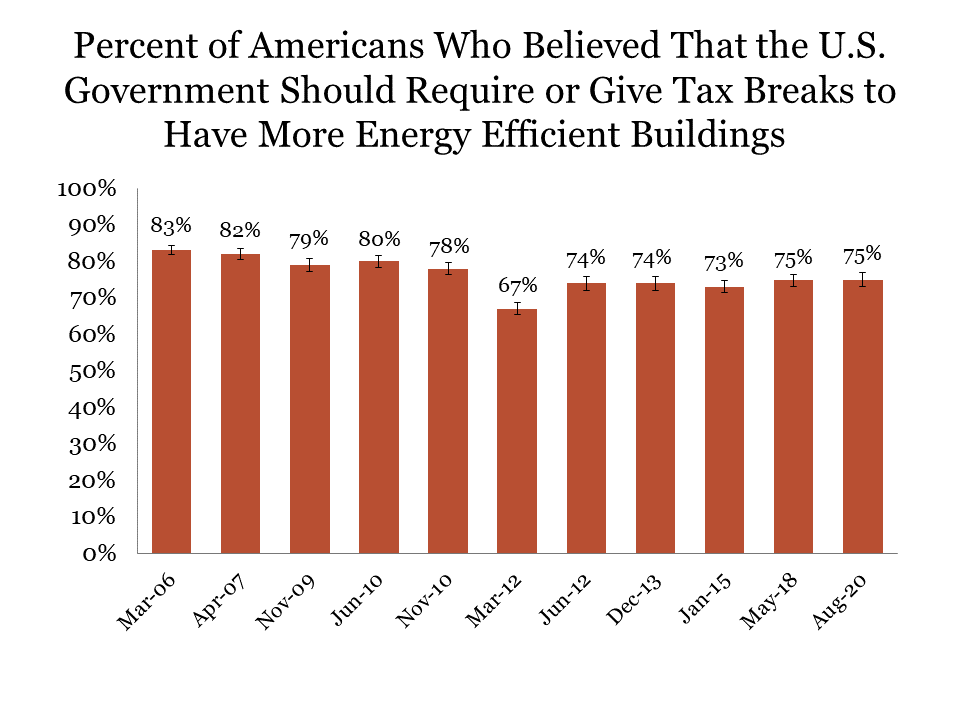
About 70-75% of Americans wanted the government to require or give tax breaks to encourage companies to develop more energy efficient appliances in recent years, with 71% of Americans reporting this belief in 2020 (see the figure below).
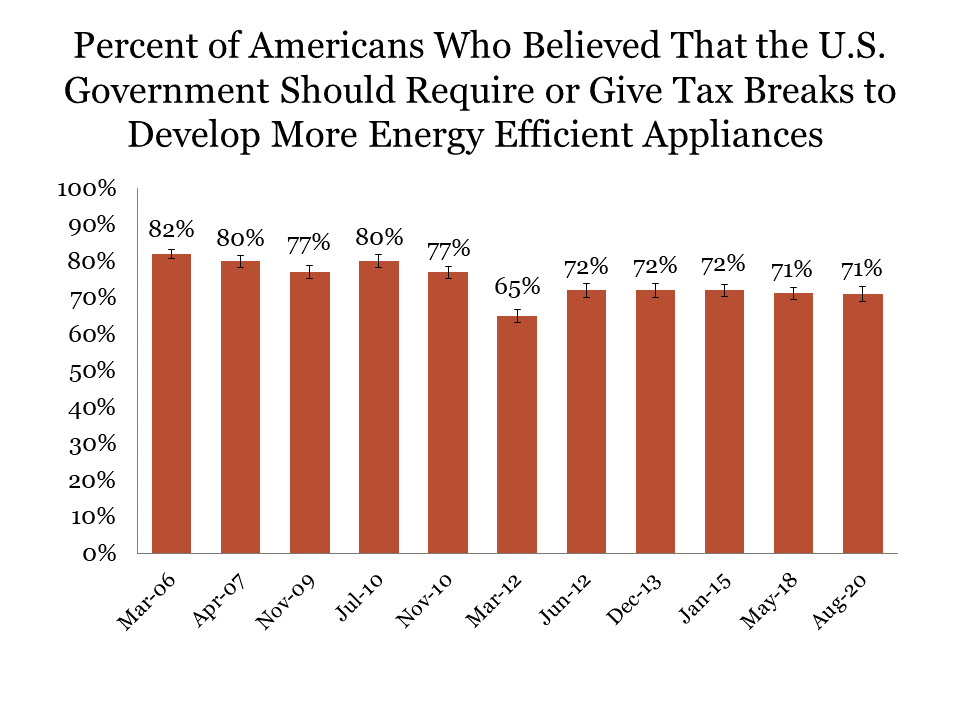
All-Electric Vehicles
In 2015, 60% of Americans believed the government should impose mandates or provide tax breaks to encourage building more all-electric vehicles (see the figure below).
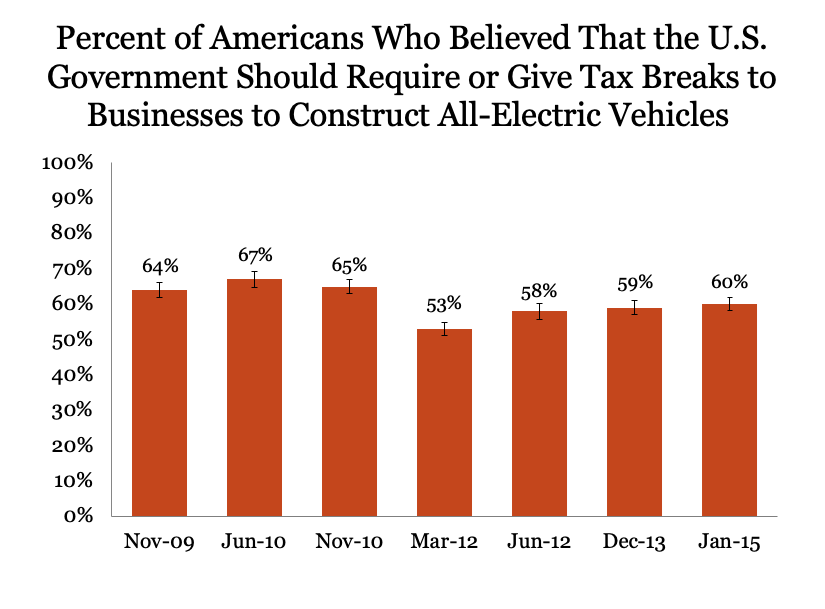
Alternate Energy Generation Methods
Huge majorities of Americans (87% in 2006 and 83% in 2020) have favored tax breaks to encourage utilities to produce more energy from renewable sources, as shown in the figure below.

In 2013, 73% of Americans favored the government giving tax breaks to companies that made electricity from sunlight, wind, and water, with a slight majority supporting tax breaks for natural gas companies as well. Tax breaks for oil companies received the least support, from only 31% (see the figure below).
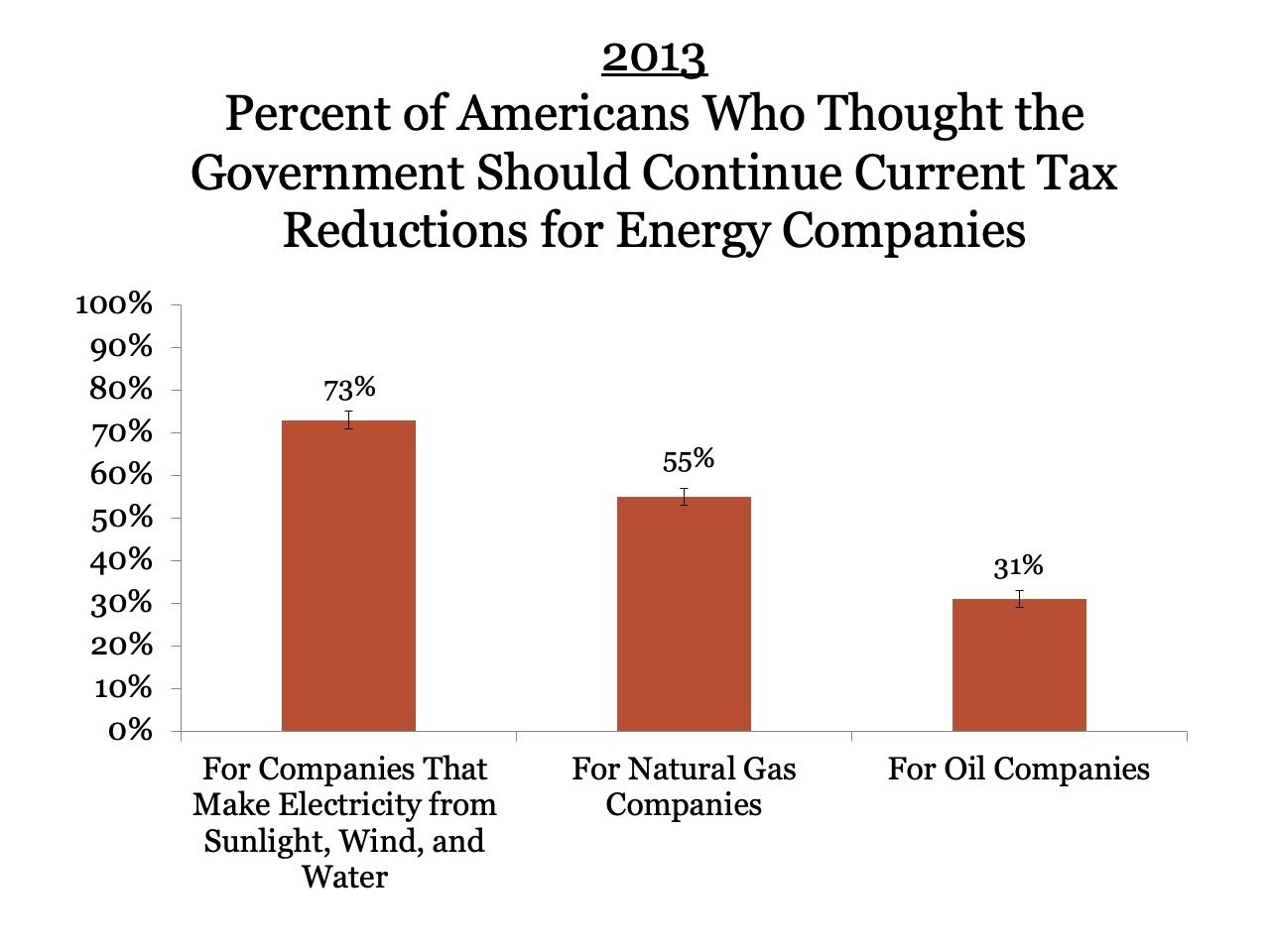
In 2008, 55% of Americans favored an increase in taxes on oil companies’ profits (see the figure below).
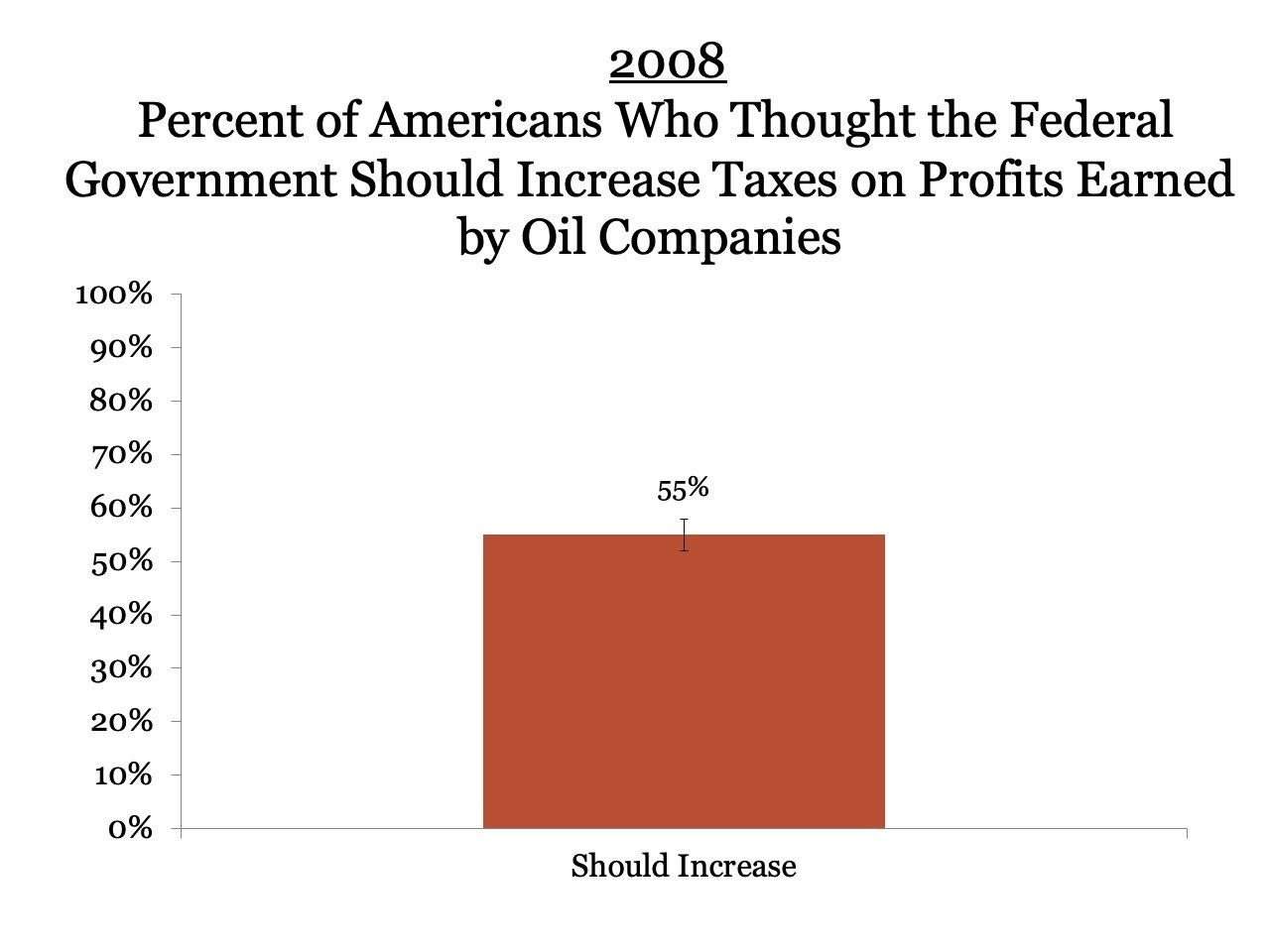
In 2010, more than two thirds of Americans wanted the government to require power companies to make at least 20% of their electricity from renewable sources such as water, wind, or solar power.
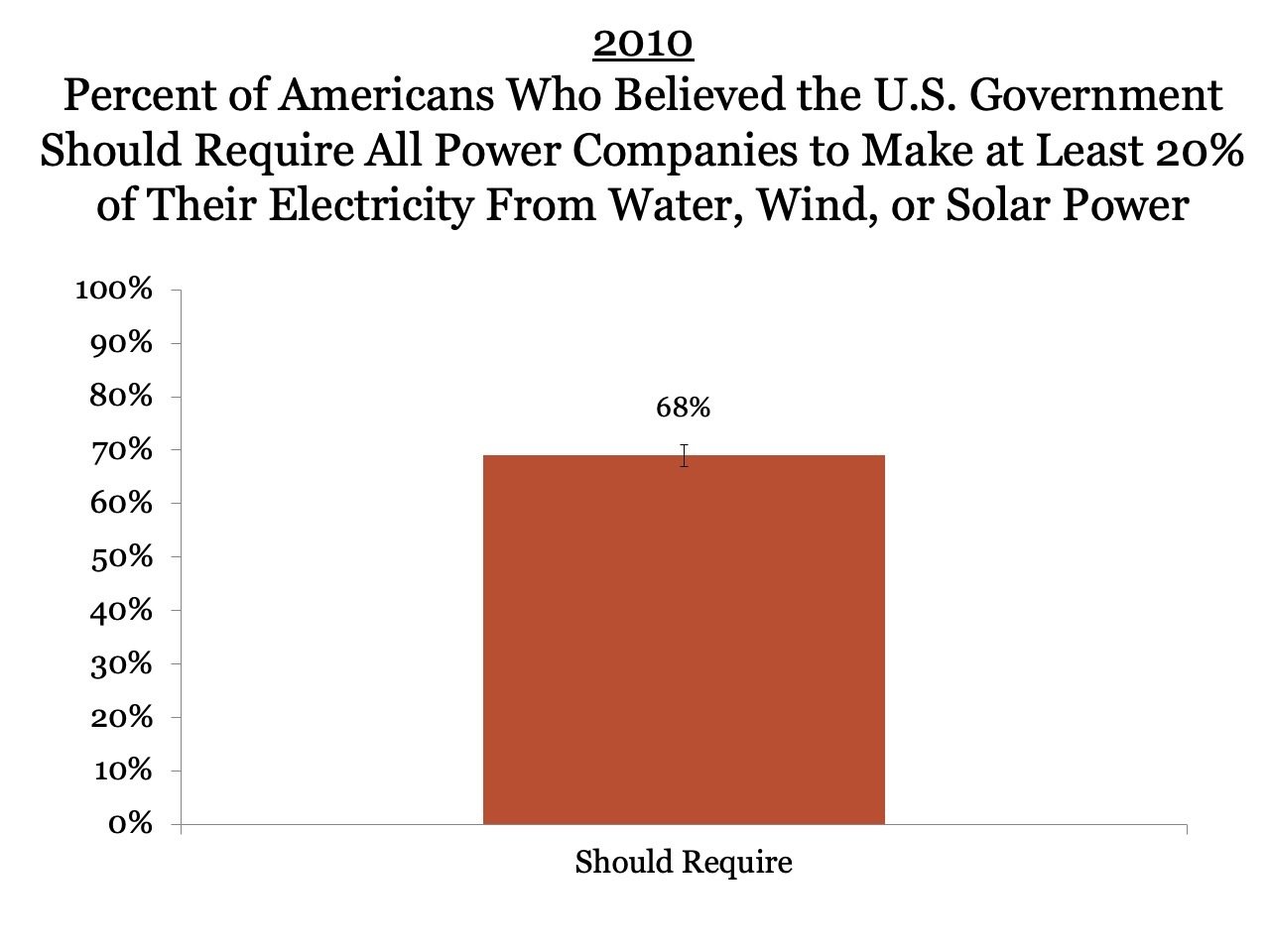
In 2013, 68% of Americans wanted the government to pay part of the cost for people to put solar panels on their homes.
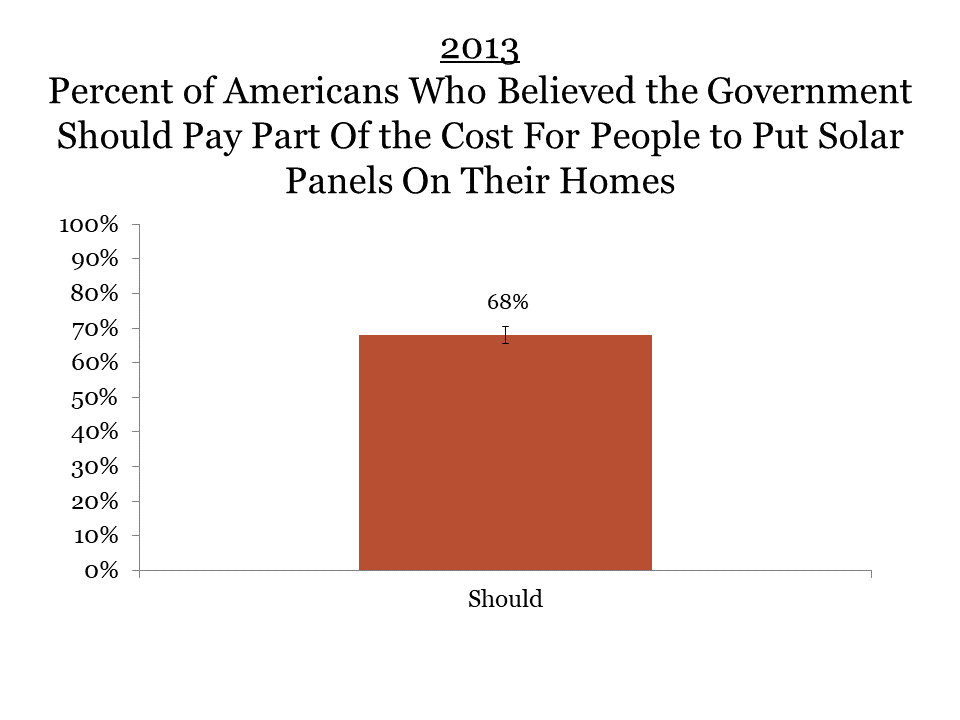
Only minorities of Americans (41% in 2006, 37% in 2020) favored tax breaks to build new nuclear power plants (see the figure below).
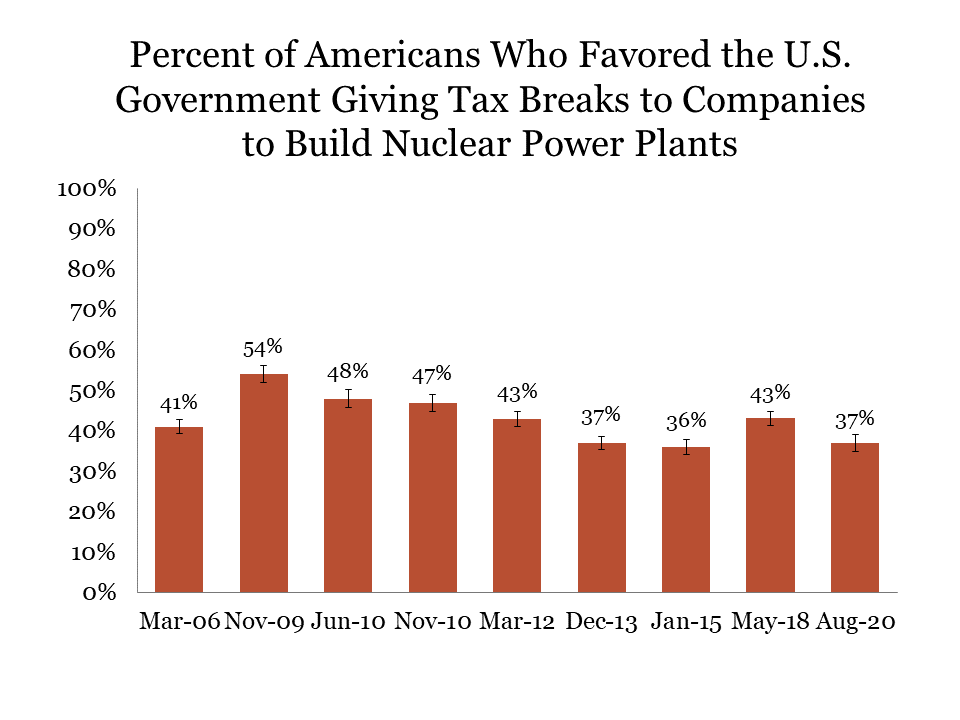
Consumer Consumption Taxes
Increasing consumer taxes to cause people to use less gasoline or electricity has been one of the less popular ideas throughout the years. In 2020, an all-time high (43%) of respondents wanted the government to raise gasoline taxes in order to cause people to use less. In prior years, support for this policy was closer to 30%.
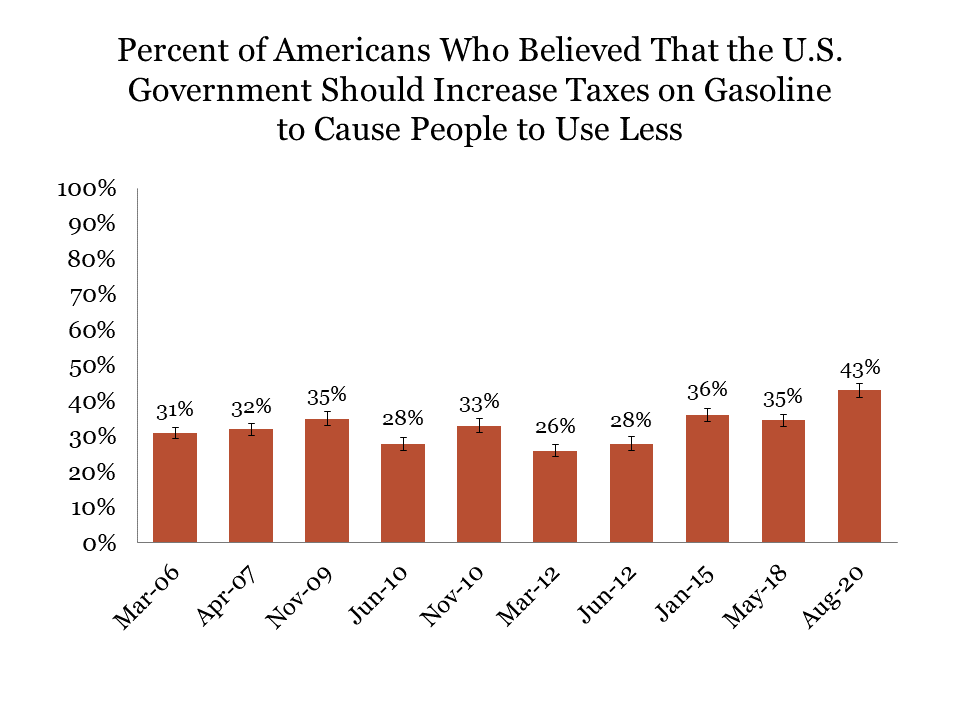
Even fewer people (19% in 2006, 28% in 2020) favored increasing electricity taxes to cause people to use less.
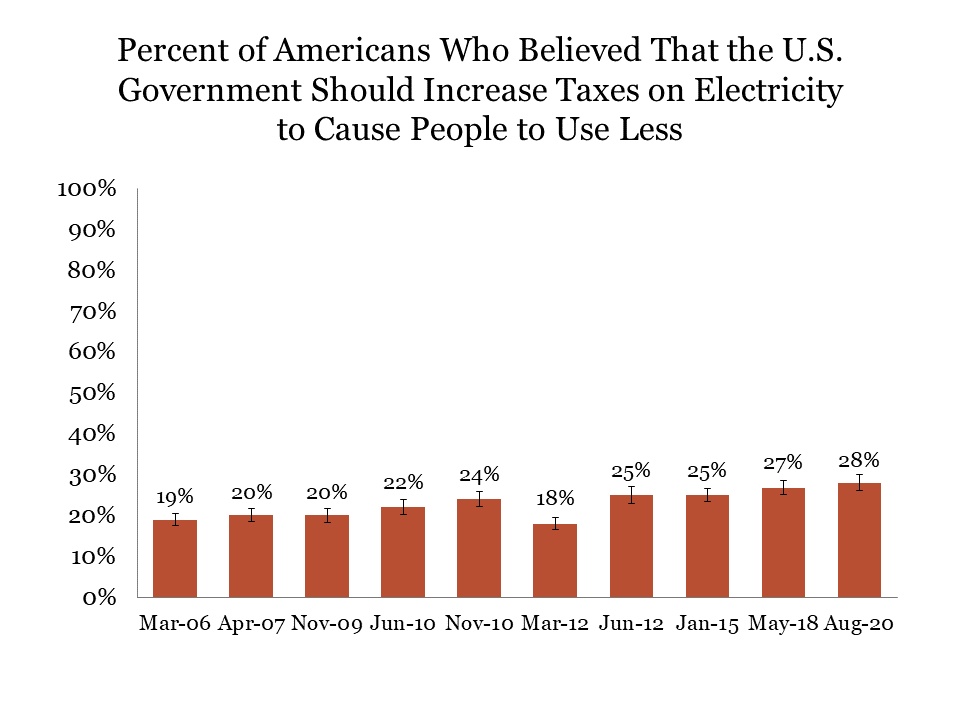
Green Stimulus
Between March and September, 2020, the federal government spent trillions of dollars to help American businesses and workers get through the economic crisis brought on by the coronavirus pandemic, and more stimulus packages continue to be debated in Congress. One way in which this money could be spent is by making investments in developing new methods and technologies to slow global warming.
In 2020, when asked whether the government should spend stimulus money during an economic crisis on creating jobs and technology to reduce future warming, about two-thirds (66%) of Americans said that the government should do this.
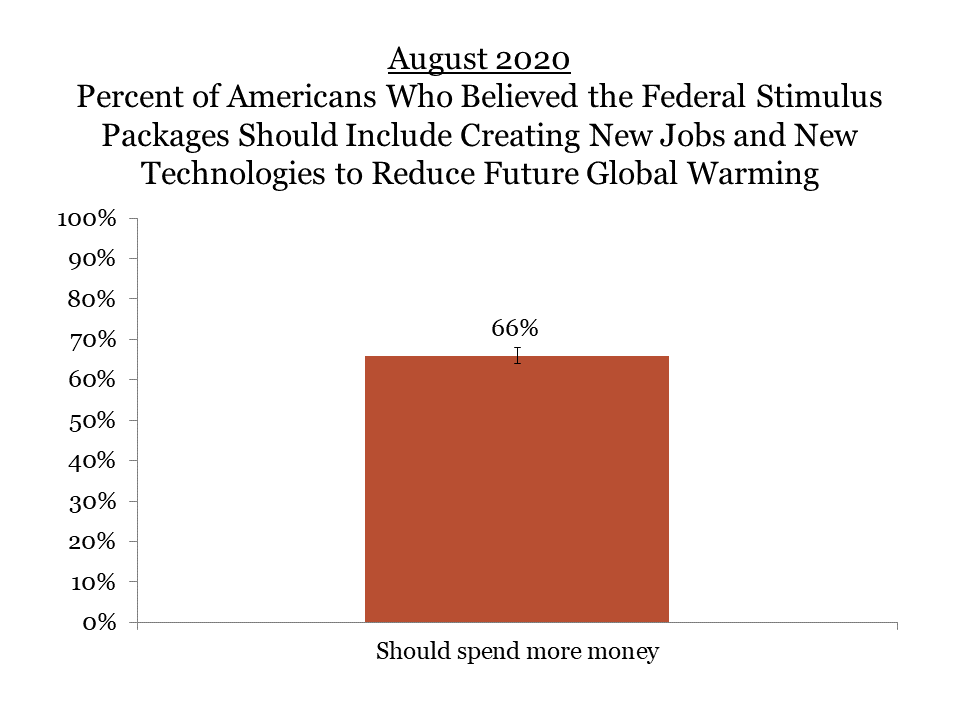
In 2020, 59% of Americans said the government should tag stimulus money to pay for planting trees to absorb greenhouse gases.
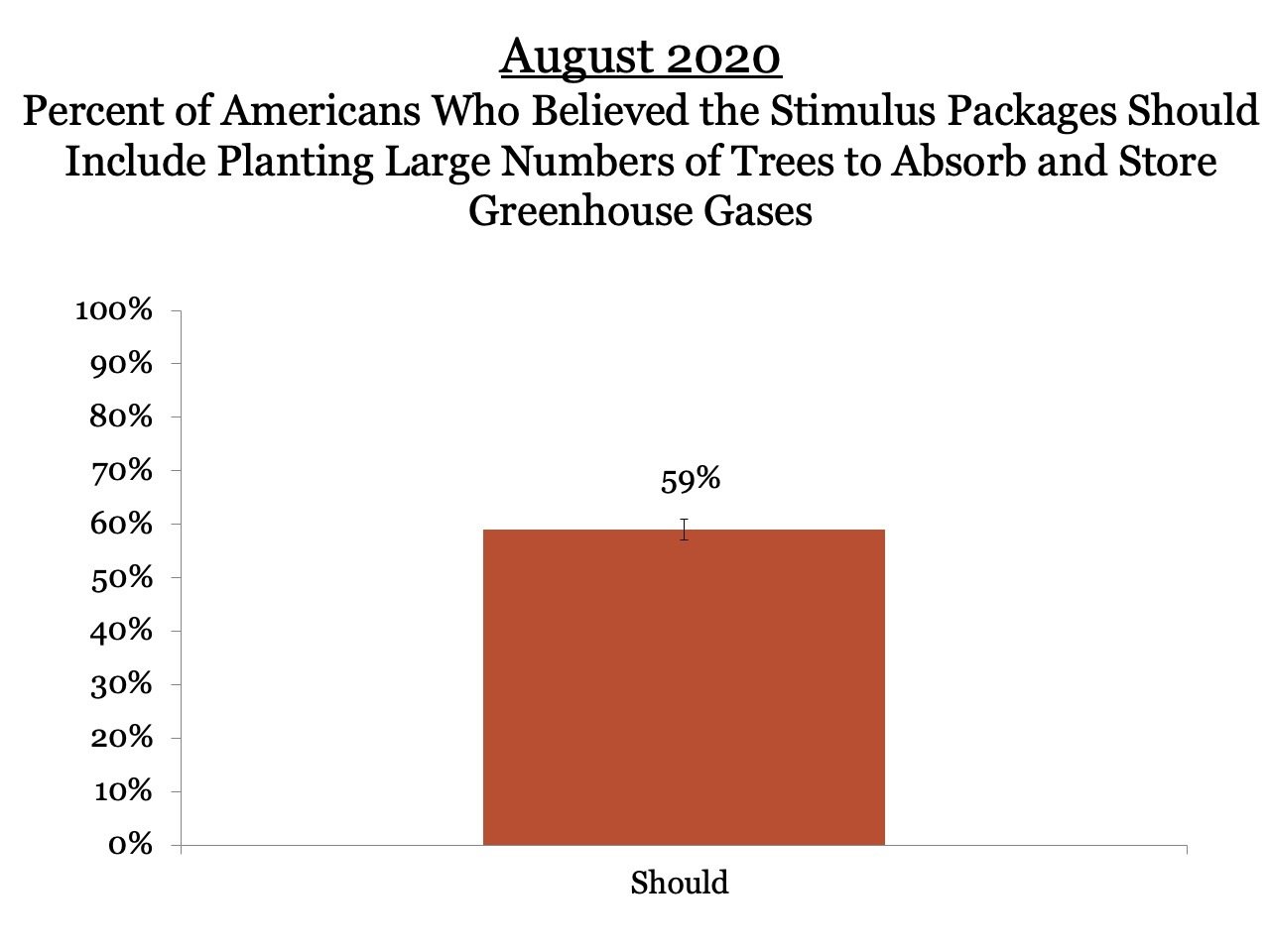
In 2020, 61% of Americans wanted the government to spend stimulus money investing in developing new, more efficient energy generation methods.
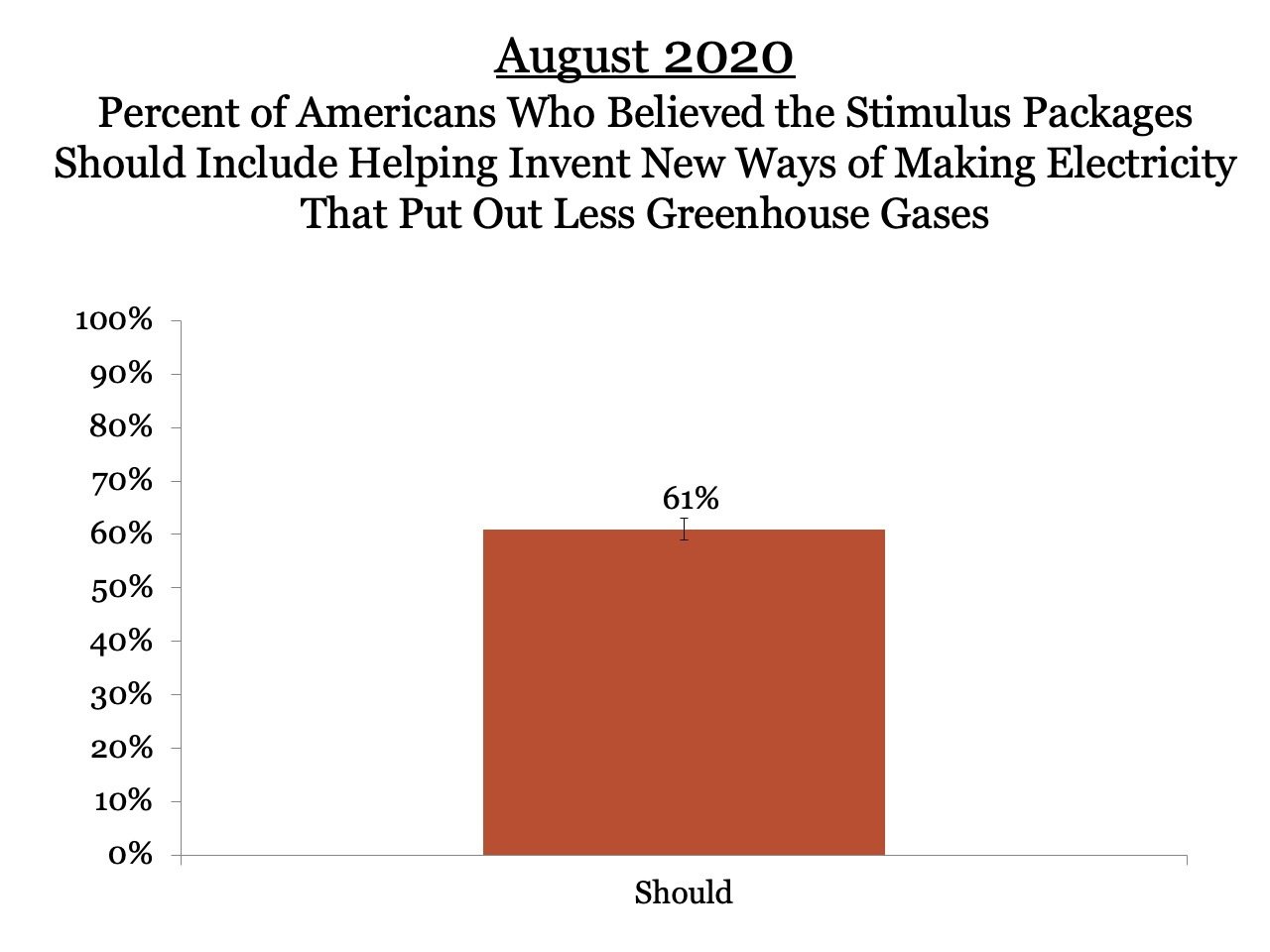
In 2020, 56% of Americans wanted stimulus money to help companies make smaller, longer-lasting batteries (56%), strengthen oil and gas pipelines to reduce leaking and pollution (54%), and installing charging equipment in parking lots to be used by electric cars and trucks (51%). Just under half of Americans favored government spending money to encourage making more cars and trucks that run entirely on electricity (45%).
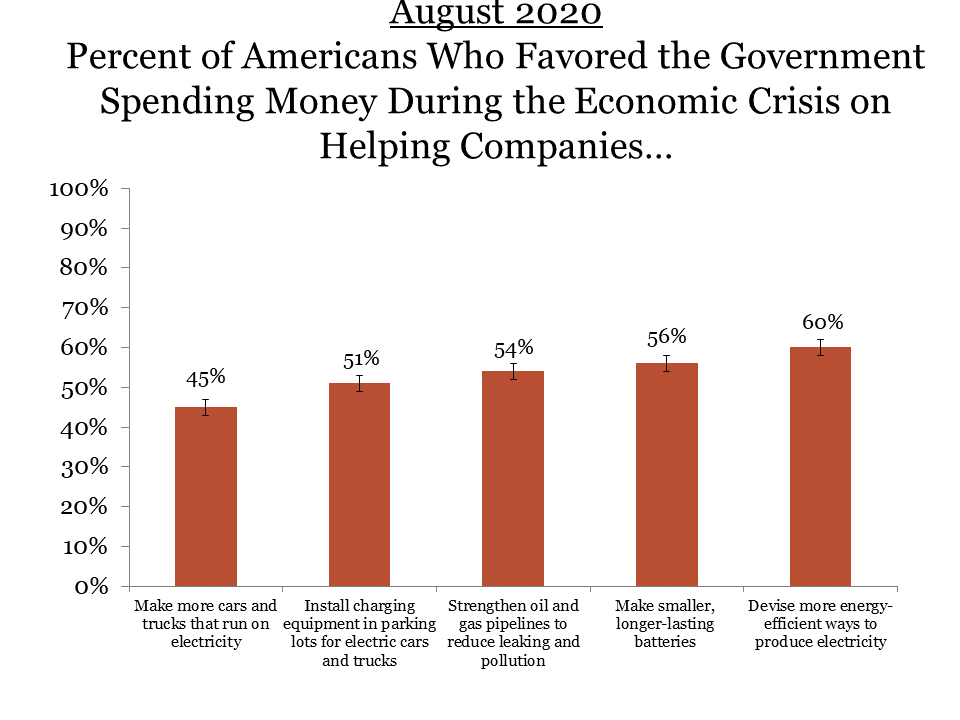
Obama-Era Mitigation Policies
In July 2020, the New York Times reviewed 100 environmental rules that the Trump administration had reversed or was in the process of undoing. Many of these rules were put in place by the Obama administration, including policies on vehicle greenhouse gas standards and mercury emissions from coal power plants (Popovich et al. 2020). We selected four of these policies on which to gauge American opinions:
- The Paris Agreement, an agreement between more than 190 countries, in which the United States pledged to produce 25% less greenhouse gas emissions in 2025 than it put out in 2005
- The Clean Power Plan, which states that, by 2030, power plants must put out 30% less greenhouse gas emissions than they did in 2005
- An executive order to cut federal greenhouse gas emissions by 40% by 2025
- An increase to the Corporate Average Fuel Economy (CAFE) standards, requiring American-made vehicles to have an average gas mileage of 55 miles per gallon by 2025
Randomly-selected survey respondents were told about the policies and were asked whether they favored or opposed each one. Rather than using the name of each policy, respondents were given the policy details; without prior knowledge, they would not necessarily have been aware that these four specific policies were those mentioned. All of the policies received majority support, in some cases by large margins.
Percent of Americans Who Supported Various Policies Implemented by the Obama Administration That the Trump Administration Rolled Back or Attempted to Roll Back

In 2020, 81% of respondents favor efforts by the federal government to lower US greenhouse gas emissions by 25% from 2005 levels by 2025, with no penalty for failing to achieve this goal. This was, of course, a major part of the US commitment to the Paris Agreement.
More than three-quarters of Americans (77%) favor a plan for the US government to require power plants to reduce their greenhouse gas emissions by 30% below 2005 levels by 2025—goals laid out in the Clean Power Plan.
Two in three Americans—66%—favor the federal government lowering its own greenhouse gas emissions by 40% by 2025, relative to 2015. Finally, 64% favor the government requiring that all new cars and trucks made in the United States after 2025 get at least 55 miles per gallon (as laid out by the CAFE standards under the Obama Administration).
Built into the questionnaire was an experiment in which some respondents were told that President Obama had spearheaded each policy, other respondents were told that President Trump had reversed the policy, and still other respondents were told about both presidents’ involvement.
This experiment was implemented to assess the malleability of American opinions regarding these policies. American professors Arthur Lupia and Mathew D. McCubbins (1998) asserted that on issues about which Americans know little or nothing, they often take cues from leaders they trust. Thus, if a policy is favored by a politician or political party whom a citizen supports, the citizen is inclined to favor the policy as well, and vice versa. We set out to gauge whether such cues would notably alter public support for these four policies that President Obama had created and President Trump reversed.
To do so, we estimated the parameters of ordinary least squares regressions predicting the number of the four policies that each respondent favored. We used variables to represent whether the respondent was told President Obama favored the policies, whether the respondent was told that President Trump reversed the policy, the respondents’ liberal/conservative ideology, and demographics.
In fact, neither of these hypotheses was confirmed. In general, public support for these policies was not increased or decreased by endorsement from a politician of the respondent’s party.
Among Democrats, mentioning President Obama’s support of the policies did not increase policy support.
Among Independents, neither mentioning President Obama’s support nor mentioning President Trump’s opposition to the policies altered support for them.
Among Republicans, mentioning President Trump’s opposition to the policies did not decrease support either.
Interestingly, the only support for the notion that cues would be consequential appeared among Republicans—mentioning that President Obama had spearheaded the policies reduced support by 15 percentage points.
Predictors of Support for Policies Given a Presidential Association (August 2020)
